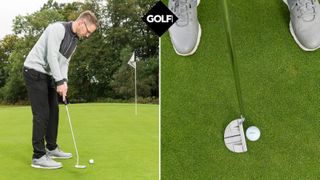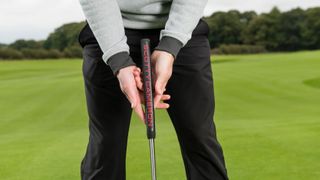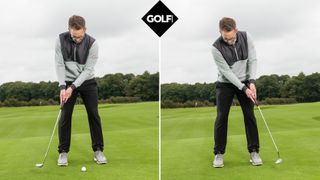Putting Backswing Vs Follow Through
In this video, PGA pro Nick Drane shares his tips on how to hone a much more efficient putting stroke


Golf Monthly created this content as part of a paid partnership with Titleist. The contents of this article are entirely independent and solely reflect the editorial opinion of Golf Monthly.
Putting Backswing Vs Follow Through
A good putting performance can salvage a bad round and turn a good score into a personal best, which is why it's so frustrating when this part of the game is letting you down. In the video and article below, PGA pro Nick Drane clears up some common misconceptions when it comes to the putting stroke that are sure to help.
You will often hear people talk about the importance of accelerating the putter through impact. We certainly don't want to be decelerating, but if you watch the best putters in the world, they keep the putter head at a constant speed. Understanding this will help you discover the flow that is often behind a great putting stroke.
Thinking too much accelerating the head can lead to a few problems, the first of which concerns distance control. Put simply, it makes it hard to be consistent from range.

A short backswing (left) will result in a jerky motion and lead to pulls (right)
So, what you tend to see is this short backswing, and then a long, jerky follow-through. As well as making it hard to get the distance right, it also makes it difficult to maintain a square clubface towards your intended target line - so you can clearly see in the video above how that makes me pull it left of target.
Fundamentals
Whether you hold the putter conventionally, adopt the left hand low putting grip, or even utilise the claw grip, working on the basics at set-up will help you understand the importance of matching the backswing and follow-through.

Make sure and keep your grip pressure nice and light when putting
I take the putter in the palms of my hands and adopt a nice, wide base. What you're trying to remove is any unnecessary wrist movement that will give acceleration to that putter head. A good address position will help you find more control of the putter without needing to grip it any tighter.
Get the Golf Monthly Newsletter
Subscribe to the Golf Monthly newsletter to stay up to date with all the latest tour news, equipment news, reviews, head-to-heads and buyer’s guides from our team of experienced experts.
Use Your Feet
You can use your feet as a reference for the length of stroke. So, if you watch the backswing and follow-through in the video, you'll see how they are very similar in length. By keeping the length of the stroke fairly consistent - back and through - you should be able to maintain control of the clubface and judge distance more easily.

Use your feet to help judge the length of backswing and follow-through
Obviously, during a game of golf we're going to be faced with putts of different lengths. The key to being successful with putting from distance, is to maintain a very similar length backswing and follow-through.
Tee Peg Drill
This is a simple drill that will help you to focus on your backswing and follow-through - and, ultimately, improve your ability to judge putting distance. Place a tee peg 10ft, 20ft and 30ft away, and practise putting to each one. See how close you can maintain that grouping.

This is a great drill to work on your stroke and distance control
Even just varying the length of your stroke - so just outside the back foot, to just outside the front foot - and observing what distance that produces, is going to be extremely valuable and when it comes to improving your putting feel.
Three-Ball Window
A good drill that provides a nice visual to help you focus on clubface control, is the three-ball window. Think about how you need to keep the clubface square through this zone. It's more a visual to have, or you can hover the putter over the three balls and make a stroke.
No matter the puttMost of the great putters in the world of golf have a flow and rhythm to their stroke. These tips and drills will help with your backswing and follow-through to create that smooth stroke that will lead to more putts finding the target.

Michael has been with Golf Monthly since 2008. As a multimedia journalist, he has also worked for The Football Association, where he created content to support the men's European Championships, The FA Cup, London 2012, and FA Women's Super League. As content editor at Foremost Golf, Michael worked closely with golf's biggest equipment manufacturers, and has developed an in-depth knowledge of this side of the industry. He's now a regular contributor, covering instruction, equipment and feature content. Michael has interviewed many of the game's biggest stars, including six world number ones, and has attended and reported on many Major Championships and Ryder Cups. He's a member of Formby Golf Club.
-
 'Gator Netting Is In Place' - Chevron Championship Venue Prepared For 'Safe' Winner's Jump
'Gator Netting Is In Place' - Chevron Championship Venue Prepared For 'Safe' Winner's JumpA tradition which began at the tournament's previous home could continue this year - if the champion is feeling brave enough...
By Jonny Leighfield Published
-
 New Balance 997 SL Golf Shoe Review
New Balance 997 SL Golf Shoe ReviewNew Balance produce some extremely stylish footwear and, in this review, Matt Cradock takes their spikeless 997 SL onto the course
By Matt Cradock Published